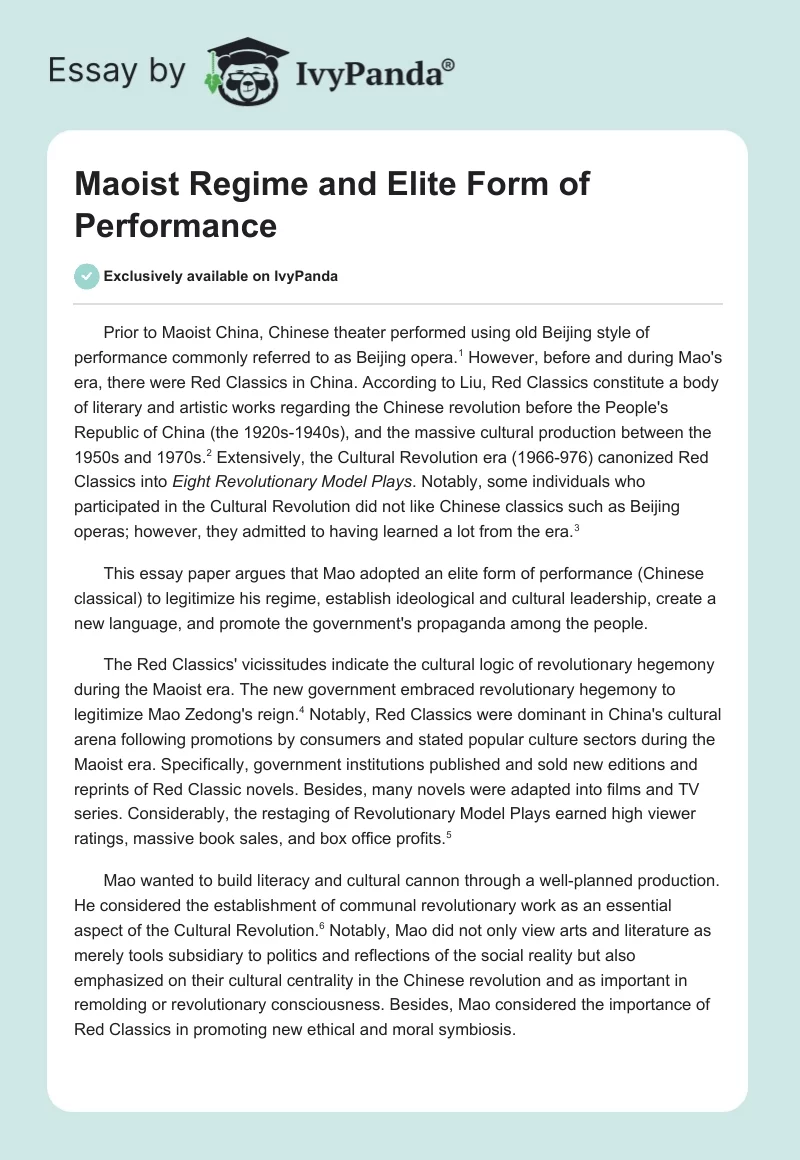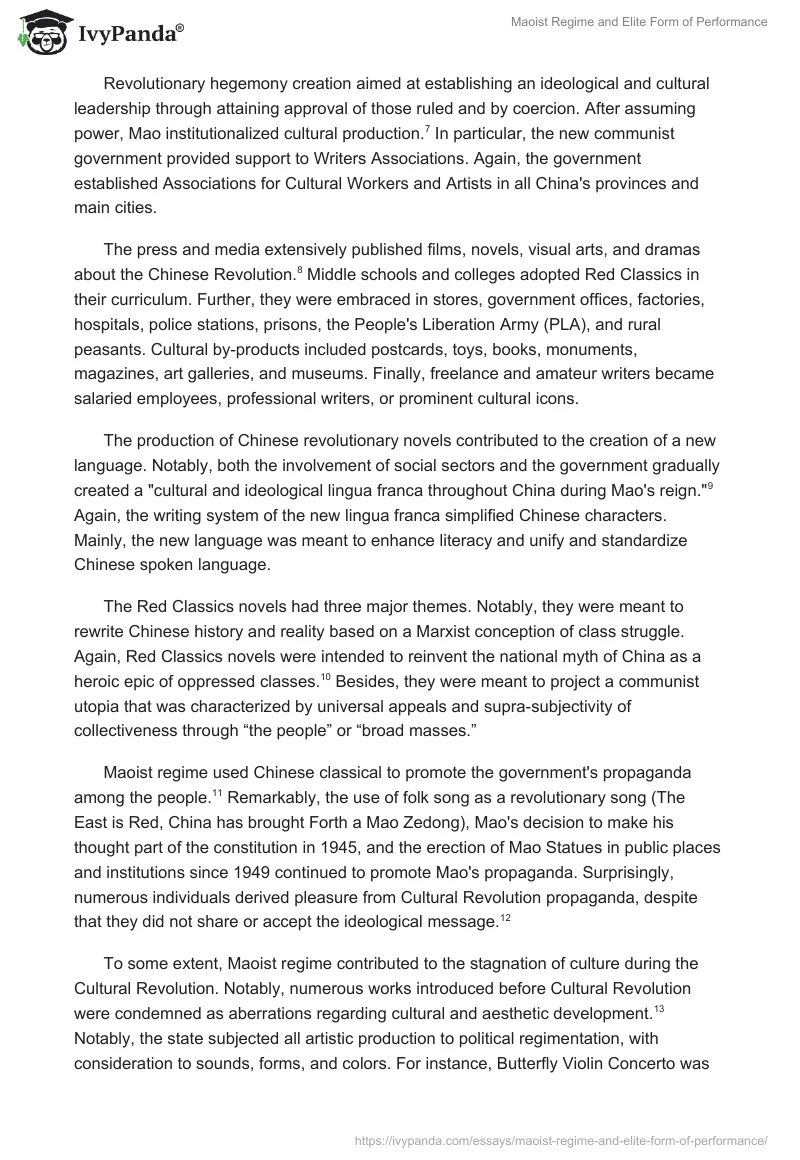Prior to Maoist China, Chinese theater performed using old Beijing style of performance commonly referred to as Beijing opera. However, before and during Mao’s era, there were Red Classics in China. According to Liu, Red Classics constitute a body of literary and artistic works regarding the Chinese revolution before the People’s Republic of China (the 1920s-1940s), and the massive cultural production between the 1950s and 1970s. Extensively, the Cultural Revolution era (1966-976) canonized Red Classics into Eight Revolutionary Model Plays. Notably, some individuals who participated in the Cultural Revolution did not like Chinese classics such as Beijing operas; however, they admitted to having learned a lot from the era.
This essay paper argues that Mao adopted an elite form of performance (Chinese classical) to legitimize his regime, establish ideological and cultural leadership, create a new language, and promote the government’s propaganda among the people.
The Red Classics’ vicissitudes indicate the cultural logic of revolutionary hegemony during the Maoist era. The new government embraced revolutionary hegemony to legitimize Mao Zedong’s reign. Notably, Red Classics were dominant in China’s cultural arena following promotions by consumers and stated popular culture sectors during the Maoist era. Specifically, government institutions published and sold new editions and reprints of Red Classic novels. Besides, many novels were adapted into films and TV series. Considerably, the restaging of Revolutionary Model Plays earned high viewer ratings, massive book sales, and box office profits.
Mao wanted to build literacy and cultural cannon through a well-planned production. He considered the establishment of communal revolutionary work as an essential aspect of the Cultural Revolution. Notably, Mao did not only view arts and literature as merely tools subsidiary to politics and reflections of the social reality but also emphasized on their cultural centrality in the Chinese revolution and as important in remolding or revolutionary consciousness. Besides, Mao considered the importance of Red Classics in promoting new ethical and moral symbiosis.
Revolutionary hegemony creation aimed at establishing an ideological and cultural leadership through attaining approval of those ruled and by coercion. After assuming power, Mao institutionalized cultural production. In particular, the new communist government provided support to Writers Associations. Again, the government established Associations for Cultural Workers and Artists in all China’s provinces and main cities.
The press and media extensively published films, novels, visual arts, and dramas about the Chinese Revolution. Middle schools and colleges adopted Red Classics in their curriculum. Further, they were embraced in stores, government offices, factories, hospitals, police stations, prisons, the People’s Liberation Army (PLA), and rural peasants. Cultural by-products included postcards, toys, books, monuments, magazines, art galleries, and museums. Finally, freelance and amateur writers became salaried employees, professional writers, or prominent cultural icons.
The production of Chinese revolutionary novels contributed to the creation of a new language. Notably, both the involvement of social sectors and the government gradually created a “cultural and ideological lingua franca throughout China during Mao’s reign.” Again, the writing system of the new lingua franca simplified Chinese characters. Mainly, the new language was meant to enhance literacy and unify and standardize Chinese spoken language.
The Red Classics novels had three major themes. Notably, they were meant to rewrite Chinese history and reality based on a Marxist conception of class struggle. Again, Red Classics novels were intended to reinvent the national myth of China as a heroic epic of oppressed classes. Besides, they were meant to project a communist utopia that was characterized by universal appeals and supra-subjectivity of collectiveness through “the people” or “broad masses.”
Maoist regime used Chinese classical to promote the government’s propaganda among the people. Remarkably, the use of folk song as a revolutionary song (The East is Red, China has brought Forth a Mao Zedong), Mao’s decision to make his thought part of the constitution in 1945, and the erection of Mao Statues in public places and institutions since 1949 continued to promote Mao’s propaganda. Surprisingly, numerous individuals derived pleasure from Cultural Revolution propaganda, despite that they did not share or accept the ideological message.
To some extent, Maoist regime contributed to the stagnation of culture during the Cultural Revolution. Notably, numerous works introduced before Cultural Revolution were condemned as aberrations regarding cultural and aesthetic development. Notably, the state subjected all artistic production to political regimentation, with consideration to sounds, forms, and colors. For instance, Butterfly Violin Concerto was officially condemned during Cultural Revolution due to a romantic love story for an individual rather than for the party and the communist cause.
The Chinese communist culture accepted the “female self-beautification within the parameters of the revolutionary aesthetic principles of frugality.” As such, self-adornment was common in operas and ballets. For instance, hair decorations (ribbons and bows or flowers) were common in many young rural women who participated in the model ballets and operas. Control in self-adornment was considered as a sign of political liberalism.
Beauty is highly notable in characters from works such as The Red Lantern, Taking Tiger Mountain by Strategy, Song of the Dragon River, and The White Haired Girl. The government and social sectors reprinted and revised these works on numerous occasions in the 1950s to fit their objectives.
In 1960’s socialist rural China, the main costume colors were apparent gender differentiated. Notably, women costume colors included turquoise, pink, peach, and pale blue colors. On the other hand, the principal men costume colors were red, blue, and yellow. Remarkably, some of the classic novels during the communist period showed an existence of a relationship between pink, seductive female sexuality, and femininity during Maoist culture. For instance, in the Tracks in the Snowy Forest (a 1957 novel), two concubines of Landlord Fan took opium to bandits and seductively attempted to distract them using their pink nightgowns.
The red color was associated with beautiful women. Mainly, beautiful women were referred with names such as “red jade”, “red countenance”, and “rouge and powder.” Notably, their sweat was called “red sweat” while their tears were called “red tears.” Women garment terms included “red attire”, “red sleeves”, “red skirt.” On men, red costume symbolized courage, status, and loyalty of male Beijing performers
In conclusion, During Mao’s reign, the country witnessed an increased popularity of Red Classics such as novels, films, TV series, and operas. Notably, some Red Classics were condemned in the public due to their inherent messages. Mainly, Maoist regime has adopted Red Classics to achieve numerous objectives. For instance, Red Classics were used to legitimize Moa Zedong reign. Again, they acted as a tool of establishing an ideological and cultural leadership by winning the consent of the ruled or through coercion.
Besides, Red Classics engineered the creation of a new lingua franca, which enhanced literacy, unified and standardized spoken the Chinese language. In addition, Mao regime used Chinese classical to promote government’s propaganda, which admittedly people enjoyed despite that they did not share or accept the inherent messages. In classical works such as novels and operas, Maoist regime approved the inclusion of beautification through costumes and gender-differentiated colors that reflected the revolutionary artistic principles of frugality.
Bibliography
Liu, Kang. “Reinventing the ‘‘Red Classics’’ in the Age of Globalization.” Neohelicon 37, no 2 (2010): 329–347.
Mittler, Barbara. “A Popular Propaganda? Art and Culture in Revolutionary China.” Proceedings of the American Philosophical Society 152 no. 4 (2008): 466-489.
Roberts, Rosemary. “Gendering the Revolution Body: Theatrical Costume in Cultural Revolution China.” Asian Studies Review 30, no. 2 (2006): 141-159.


